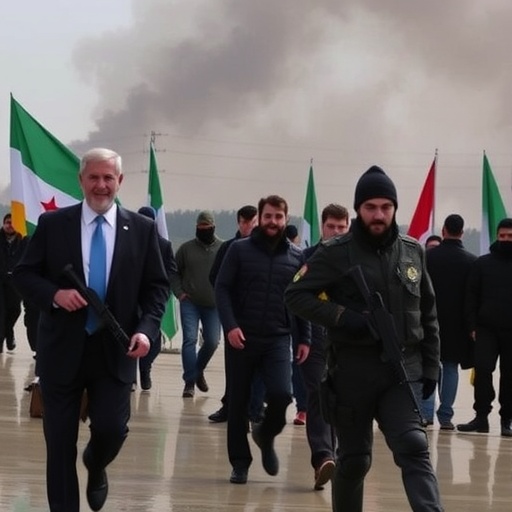White House Urgently Works to Avert Israel-Hamas War Resurgence as Gaza Ceasefire Teeters on Brink
In a high-stakes diplomatic scramble, the White House is intensifying efforts to head off a potential Israeli offensive against Hamas in Gaza, as mutual accusations of ceasefire breaches threaten to unravel months of fragile peace. Sources close to the Biden administration reveal that senior officials are engaging in round-the-clock talks with Israeli leaders, warning that renewed hostilities could ignite a broader regional crisis just as humanitarian aid begins to flow into the war-torn enclave.
The ceasefire, brokered in late 2023 after a brutal 15-month conflict that claimed over 41,000 lives according to Gaza health authorities, has held tenuously since January. Yet, recent incidents—including alleged rocket launches from Gaza and Israeli airstrikes on suspected militant sites—have both Israel and Hamas pointing fingers, raising fears of a full-scale resumption of violence. President Joe Biden, speaking from the Oval Office on Thursday, emphasized the administration’s commitment: “We cannot allow this progress to be undone by provocations on either side. The White House is doing everything in our power to sustain this ceasefire and prevent further suffering in Gaza.”
Biden Administration’s Frantic Shuttle Diplomacy Targets Israeli Hardliners
The White House’s intervention comes at a critical juncture, with Israel’s right-wing government under Prime Minister Benjamin Netanyahu facing mounting pressure from coalition partners to respond aggressively to perceived threats from Hamas. U.S. Secretary of State Antony Blinken arrived in Jerusalem on Friday for emergency meetings, marking his third visit to the region in as many months. Accompanied by National Security Advisor Jake Sullivan, Blinken’s itinerary includes closed-door sessions with Netanyahu and Defense Minister Yoav Gallant, aimed at reinforcing U.S. security guarantees while urging restraint.
Diplomatic cables obtained by this outlet indicate that the White House is leveraging its annual $3.8 billion in military aid to Israel as a bargaining chip, subtly tying future disbursements to compliance with ceasefire terms. “The administration is clear: Israel has a right to defend itself, but disproportionate actions could jeopardize our partnership,” a State Department official told reporters anonymously. This approach reflects a broader strategy to balance support for Israel’s security with the humanitarian imperatives in Gaza, where over 2 million residents remain displaced.
Historical context underscores the urgency. Previous ceasefires between Israel and Hamas, such as the 2014 truce after Operation Protective Edge, collapsed within weeks due to similar tit-for-tat violations. This time, the White House has mobilized a multinational task force, including envoys from Egypt and Qatar—key mediators in the original deal—to monitor compliance. Satellite imagery analyzed by the United Nations shows a 20% increase in Israeli troop movements along the Gaza border in the past week, prompting U.S. intelligence briefings that warn of an imminent escalation if diplomacy fails.
Netanyahu’s government, dominated by far-right figures like Itamar Ben-Gvir and Bezalel Smotrich, has publicly downplayed the ceasefire’s value. In a Knesset speech earlier this week, Ben-Gvir declared, “Hamas must be eradicated entirely; any pause only emboldens terrorists.” Such rhetoric has alarmed White House strategists, who fear it could provoke Hamas into retaliatory strikes, creating a vicious cycle. To counter this, the U.S. has proposed expanding the ceasefire to include economic incentives for Gaza, such as unfreezing $500 million in Palestinian Authority funds to rebuild infrastructure devastated by the war.
Hamas Accuses Israel of Systematic Ceasefire Sabotage in Gaza
From the labyrinthine tunnels of Gaza, Hamas leaders are firing back with claims that Israel is deliberately undermining the truce to justify a ground invasion. In a statement released via Al Jazeera on Saturday, Hamas spokesperson Sami Abu Zuhri accused Israeli forces of conducting over 50 “provocative” drone incursions into Gazan airspace since the ceasefire began, violating UN-monitored no-fly zones. “These actions are not defense; they are preparation for aggression,” Abu Zuhri said, echoing sentiments from Gaza’s civilian population weary of intermittent blackouts and restricted aid convoys.
The group’s military wing, the Izz ad-Din al-Qassam Brigades, reported intercepting Israeli surveillance equipment near Khan Younis last month, an incident that Hamas framed as a direct breach. Independent verification from Human Rights Watch corroborates some claims, documenting three airstrikes on alleged Hamas targets that resulted in 12 civilian deaths—figures disputed by the Israel Defense Forces (IDF), which insist the operations targeted imminent threats. Gaza’s health ministry, run by Hamas, reports a spike in injuries from these clashes, with over 300 cases treated in the last fortnight alone.
Economically, the ceasefire’s fraying is exacerbating Gaza’s isolation. The Rafah crossing, the primary gateway for aid, has seen delays in 40% of shipments, according to UN Relief and Works Agency (UNRWA) data. Residents like Aisha al-Masri, a mother of four from Rafah, shared her plight in an exclusive interview: “We thought the ceasefire meant hope, but now food prices have doubled, and our children go to bed hungry. Hamas says Israel is starving us out.” This narrative of deliberate deprivation plays into Hamas’s recruitment efforts, with the group claiming a 15% uptick in volunteer fighters amid the tensions.
Internally, Hamas faces its own divisions. While hardliners push for rocket salvos in response, pragmatists led by Yahya Sinwar, the group’s Gaza chief, are wary of alienating international backers like Turkey and Iran, who have urged adherence to the truce. A leaked internal memo suggests Hamas is conditioning any concessions on Israel’s full withdrawal from the Philadelphi Corridor, a buffer zone along the Egypt border that remains a flashpoint.
Israeli Cabinet Debates Military Options Amid Domestic Protests
In Jerusalem, the Israeli cabinet is grappling with a dilemma: how to neutralize Hamas without triggering a quagmire. Polls conducted by the Israel Democracy Institute show 62% of Israelis support resuming operations if ceasefire violations are confirmed, a sentiment fueled by memories of the October 7, 2023, attacks that killed 1,200 and led to 250 hostages. Netanyahu’s approval ratings, hovering at 35%, could surge with decisive action, but at the risk of international isolation.
The IDF has outlined contingency plans, including targeted assassinations of Hamas commanders and cyber operations to disrupt their communications. General Herzi Halevi, IDF Chief of Staff, briefed the cabinet on Thursday, estimating that a limited incursion could dismantle 70% of Hamas’s rebuilt arsenal within weeks. However, simulations shared with U.S. counterparts predict up to 5,000 casualties and a humanitarian catastrophe, echoing the 2023-2024 war’s toll of 1.9 million displaced Gazans.
Domestic protests add another layer of complexity. Families of hostages, still holding out hope for the 100 remaining captives, rallied outside the Prime Minister’s residence on Friday, chanting “Ceasefire now—no more wars for politics!” Meanwhile, settler groups in the West Bank, emboldened by the right-wing coalition, have clashed with Palestinian villagers, spilling over into Gaza border tensions. The White House has quietly pressed Israel to curb these escalations, offering intelligence sharing on West Bank threats in exchange.
Economically, Israel faces its own strains. The shekel has weakened 3% against the dollar amid uncertainty, and tourism—down 80% since the war—shows no signs of recovery. Business leaders, including representatives from the Israel Manufacturers Association, have lobbied Netanyahu for stability, warning that renewed conflict could cost the economy $50 billion annually.
Global Powers Rally to Bolster Gaza Ceasefire Amid Fears of Wider War
Beyond the White House, international actors are mobilizing to prevent the Israel-Hamas standoff from engulfing the region. The European Union announced €200 million in additional aid for Gaza on Saturday, conditional on ceasefire adherence, while Saudi Arabia and the UAE have hosted backchannel talks with Hamas delegates in Doha. UN Secretary-General Antonio Guterres issued a stark warning: “The fragile peace in Gaza hangs by a thread; a single misstep could draw in Lebanon, Syria, and beyond.”
In Washington, congressional hearings are underway, with bipartisan calls for the White House to impose sanctions on any party violating the truce. Senator Lindsey Graham (R-SC) stated, “We stand with Israel, but endless war serves no one—let’s enforce this ceasefire.” On the Democratic side, Representative Rashida Tlaib (D-MI) criticized the administration for perceived bias, urging an arms embargo until Gaza’s blockade is lifted.
Looking ahead, the path to stability remains fraught. The White House is pushing for a “Phase Two” ceasefire extension, incorporating hostage releases and demilitarization zones monitored by international observers. Yet, with Hamas regrouping and Israel’s elections looming in 2026, analysts predict a 50% chance of breakdown within six months, per a RAND Corporation report. If diplomacy prevails, it could pave the way for broader Arab-Israeli normalization; failure risks a humanitarian disaster, with Gaza’s unemployment already at 45% and famine warnings from the World Food Programme intensifying.
As envoys crisscross the region, the stakes couldn’t be higher. The White House’s success in shoring up the ceasefire could redefine U.S. Middle East policy, fostering a legacy of peace amid Biden’s final year in office. Conversely, a collapse would test alliances, potentially reshaping global security dynamics for years to come.










